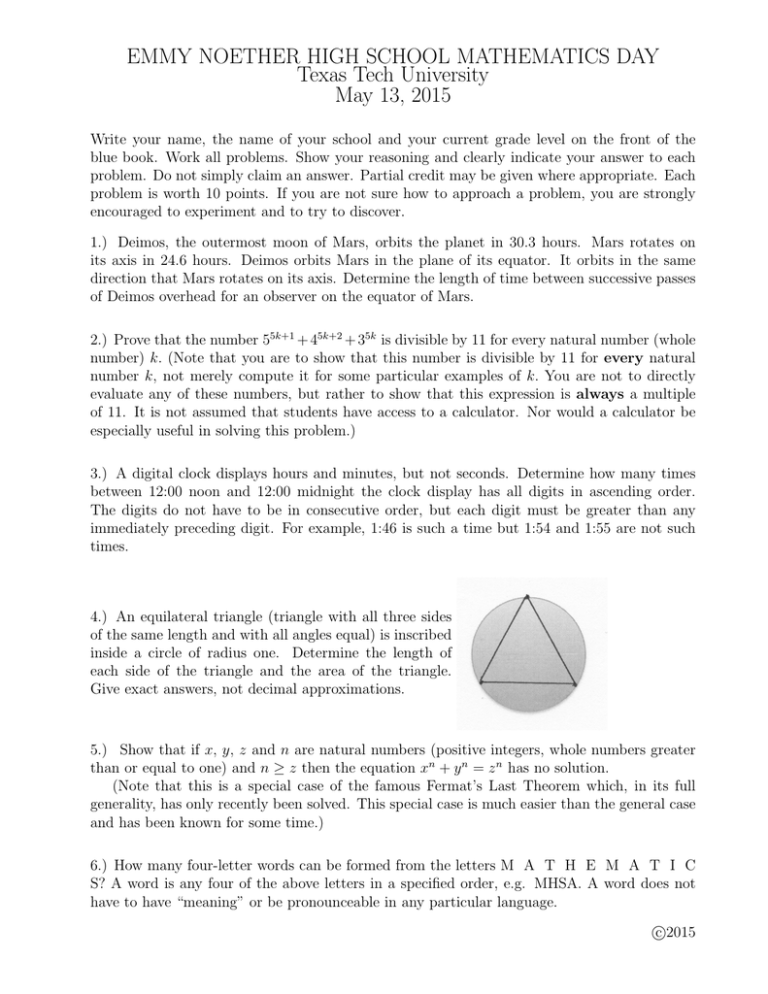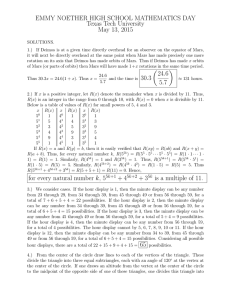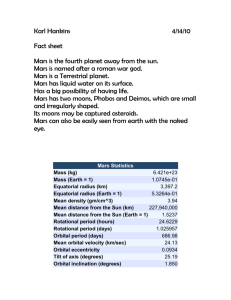EMMY NOETHER HIGH SCHOOL MATHEMATICS DAY Texas Tech University May 13, 2015
advertisement

EMMY NOETHER HIGH SCHOOL MATHEMATICS DAY Texas Tech University May 13, 2015 Write your name, the name of your school and your current grade level on the front of the blue book. Work all problems. Show your reasoning and clearly indicate your answer to each problem. Do not simply claim an answer. Partial credit may be given where appropriate. Each problem is worth 10 points. If you are not sure how to approach a problem, you are strongly encouraged to experiment and to try to discover. 1.) Deimos, the outermost moon of Mars, orbits the planet in 30.3 hours. Mars rotates on its axis in 24.6 hours. Deimos orbits Mars in the plane of its equator. It orbits in the same direction that Mars rotates on its axis. Determine the length of time between successive passes of Deimos overhead for an observer on the equator of Mars. 2.) Prove that the number 55k+1 + 45k+2 + 35k is divisible by 11 for every natural number (whole number) k. (Note that you are to show that this number is divisible by 11 for every natural number k, not merely compute it for some particular examples of k. You are not to directly evaluate any of these numbers, but rather to show that this expression is always a multiple of 11. It is not assumed that students have access to a calculator. Nor would a calculator be especially useful in solving this problem.) 3.) A digital clock displays hours and minutes, but not seconds. Determine how many times between 12:00 noon and 12:00 midnight the clock display has all digits in ascending order. The digits do not have to be in consecutive order, but each digit must be greater than any immediately preceding digit. For example, 1:46 is such a time but 1:54 and 1:55 are not such times. 4.) An equilateral triangle (triangle with all three sides of the same length and with all angles equal) is inscribed inside a circle of radius one. Determine the length of each side of the triangle and the area of the triangle. Give exact answers, not decimal approximations. 5.) Show that if x, y, z and n are natural numbers (positive integers, whole numbers greater than or equal to one) and n ≥ z then the equation xn + y n = z n has no solution. (Note that this is a special case of the famous Fermat’s Last Theorem which, in its full generality, has only recently been solved. This special case is much easier than the general case and has been known for some time.) 6.) How many four-letter words can be formed from the letters M A T H E M A T I C S? A word is any four of the above letters in a specified order, e.g. MHSA. A word does not have to have “meaning” or be pronounceable in any particular language. c 2015








